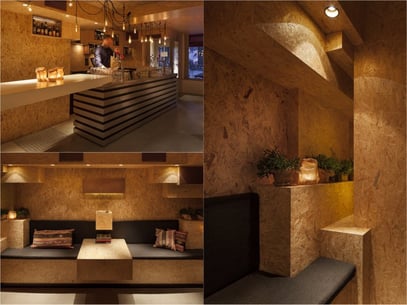5 Choices for the Interior Walls of Your Container Home
1. Drywall
Of course, drywall. It’s usually the first material you think of for the interior of a typical home. It’s inexpensive, widely available and, while it’s not super easy to put up, the learning curve is steep. It’s paintable, simple to repair and patch. If you want the interior of your container home to more closely resemble a conventional living space, drywall will have that familiarity. It’s got mass appeal.
The downside of drywall is just that it's kind of boring. Besides, why try to make a container home be exactly like a normal home? It’s not. Also, if you’re going to move your container around, there’s a good chance the drywall can start to crack.
2. Plywood
Some people think plywood walls are going to make a space feel half-finished and rough like a basement or the practice space for a high school garage band. And it will, if you don’t take the time to make it look decent. Where the edges butt against each other, there should be a very slight gap to allow for a tiny bit of expansion. Tap in a few common nails to act as spacers and keep the gap consistent. You can put a thin piece of trim to cover it up if you want.
Putting up sheets of plywood will go fast if you use a nailer with 15 or 16 ga. nails. Or, if you want to be able to take the panels down, hang them with screws. I like GRK. Using a countersink to predrill will help to give the exposed screw heads a more uniformed and finished look.
BC Pine is probably your least expensive, but not-too-rough plywood option, but it will take some sanding to make it ready for finish. Water-based polyurethane will help it keep its original color. I used oil-based poly in my container home’s plywood walls, and it gave it a yellow tint. For a moderate step above in price with a substantial step above in appearance, use baltic birch.
Also, the thinnest plywood you want to go with is ⅜”, but ½” is better. I used ¼” plywood because I was being cheap, it bows out in some places.
3. Pegboard
Hear me out. It’s pretty cheap. It’s uniform. It’s not finishable, but it is paintable. You can put little hangers everywhere and hang everything. I’ve seen it where people drape pendant lights and weave string lights all around the space. You make the whole thing into an art exhibit. Hang a plant like a philodendron and put its vines on hangers.
The downside to using pegboard as a wall paneling, besides the fact that it’s kind of weird, is that it’s thin and flimsy so it might bow out a bit. And it can’t get wet.
Pegboard walls.
Photo courtesy of Trendland.com
4. Polycarbonate sheets

I knew a vegan guy that lived out of a camper truck while he drove from Alaska to Florida. We met while I was building my container home. He told me that he had insulated the interior of his camper and covered it with polycarbonate sheets. I couldn’t really picture what he meant so he took me over to where it was parked so I could see. It actually looked pretty cool. It’s like all of the other wall paneling choices. If it’s hung thoughtfully and skillfully it will look great.
You can get these sheets in all types of colors, even clear. They are by far the lightest option, therefore they are also the most flimsy.
5. OSB

You can buy OSB panels with a foil face on the back side that acts as a radiant barrier. This isn’t a building science article, but putting it briefly, a continuous radiant barrier throughout your container home (especially the ceiling) has the potential to keep it remarkably cooler in a sunny climate.

FRP paneling is available at a wide range of price points, functions and aesthetics.
Picture courtesy of Wayfair
Super Cubes comment here! One additional comment I’d like to add in! We totally agree with everything Sterling has above. We’d like to throw in a 6th option - FRP paneling. We’ve been using this on our custom mods for customers. It can range from a low-cost, cleanable surface to a high-end look to complete the interior of a container and keep the branding consistent. The options are unlimited these days. Usually the application is that we put in plywood and then apply the paneling over it.
Although we were revisiting that and Sterling pointed out he had learned so much since writing that. He wrote an update for that posting as well.
March 22, 2022

